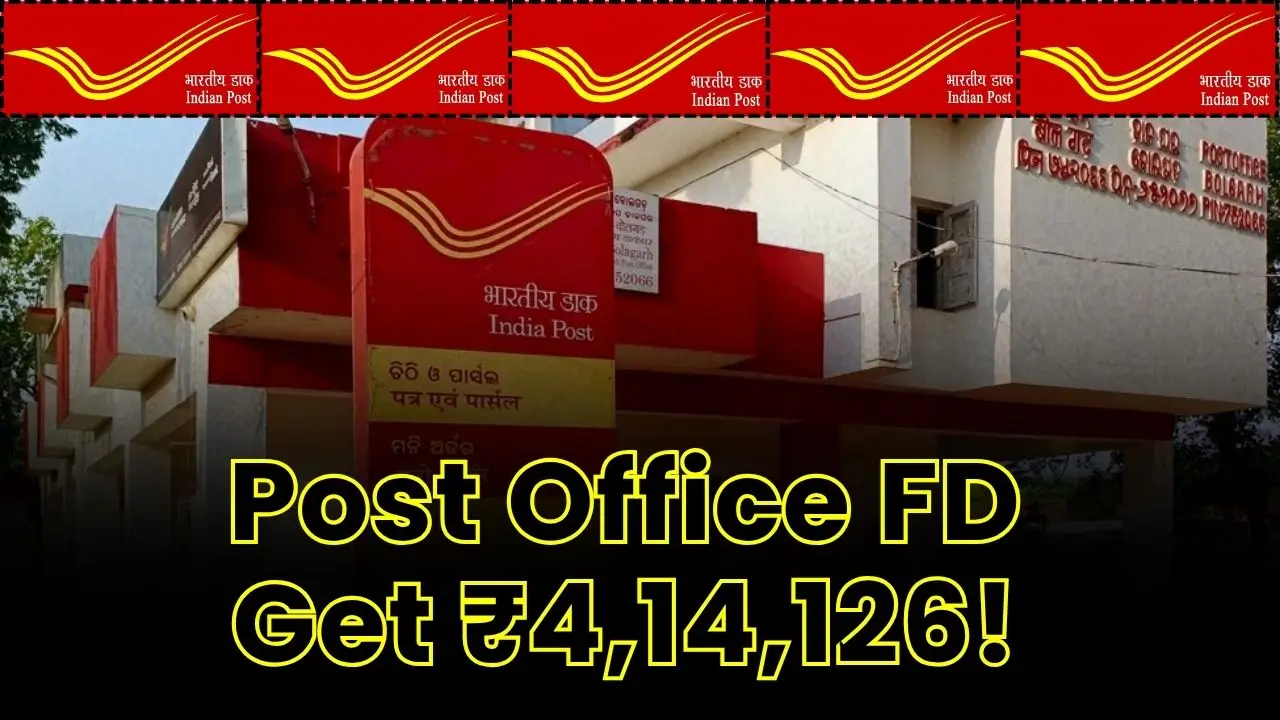A 5-year Post Office Time Deposit at a 7.5% slab can grow ₹4,00,000 to roughly ₹5.7–₹5.8 lakh because the interest compounds quarterly and gets credited annually. That combination predictable compounding, fixed rate for the full tenure, and sovereign backing makes it a reliable choice for stability-first savers who want clarity on outcomes without market swings. If the goal is to turn a lump sum into a known maturity value with minimal complexity, this setup delivers exactly that.

“Grow ₹4 Lakh to ₹5.8 Lakh with Post Office FD” isn’t hype its straightforward math under the 5-year, 7.5% slab. With quarterly compounding, the maturity typically lands in the upper ₹5.7 lakh range for ₹4 lakh at term end. Because compounding happens four times a year but the interest is credited once annually, the effective growth edges past simple annual interest methods and stacks up well over a five-year runway.
Grow ₹4 Lakh to ₹5.8 Lakh with Post Office FD
| Item | Details |
|---|---|
| Scheme | National Savings Time Deposit (Post Office FD/TD) |
| Tenures | 1, 2, 3, 5 years |
| Current rates (Oct–Dec 2025) | 6.9% (1y), 7.0% (2y), 7.1% (3y), 7.5% (5y) |
| Compounding/payout | Quarterly compounding; interest paid annually |
| 5-year advantage | Highest slab at 7.5%; also available as tax-saving TD |
| Formula | M = P × (1 + r/4)^(4n) |
| Access | Open at post offices; nomination/minor accounts supported |
Post Office FD 5-Year Plan
The 5-year slab is popular for a reason: it offers the highest rate and the longest compounding period. The rate is reviewed by the government quarterly but gets locked for the full term once the account is opened no mid-term surprises. The interest compounds quarterly but lands in the account once a year. That structure is ideal for savers who prefer a yearly cash flow while keeping the compounding engine running in the background.
How ₹4,00,000 Reaches ~₹5.8 Lakh
Use the quarterly compounding formula M = P × (1 + r/4)^(4n). With P = 4,00,000; r = 0.075; n = 5, the maturity commonly sits near ₹5.7–₹5.8 lakh. Two forces drive this outcome: the 7.5% slab itself and the quarterly compounding frequency. Shorter tenures don’t enjoy the same runway, and their slabs are a bit lower, so the combined effect produces significantly smaller maturities.
Rates This Quarter
For October–December 2025, the standard Time Deposit slabs are 6.9%, 7.0%, 7.1%, and 7.5% for 1, 2, 3, and 5 years respectively. Booking a TD now locks the chosen rate for the entire tenure on day one. That’s handy for planning goals—education funds, a future vehicle purchase, or a safety reserve without worrying about rate drift after opening.
Why Choose Post Office FD
- Safety-first capital parking backed by sovereign assurance.
- Fixed returns, transparent compounding, and predictable cash flow.
- Clean rules, nationwide access, and compatibility with basic KYC.
Post Office FD Eligibility, Account Types, and KYC
- Who can open: Individuals (single or joint), guardians for minors, and minors above 10 years as per scheme norms.
- Documents: Standard KYC, ID proof, address proof, photographs, and PAN where applicable.
- Minimum deposit: ₹1,000 in multiples thereof; no arbitrary upper cap beyond scheme compliance norms.
- Joint holding: Up to three account holders typically allowed; choose joint mode (A or E/S) thoughtfully for succession planning.
- Nomination: Strongly recommended; update promptly after major life events.
Tax and Liquidity Notes
- Section 80C benefit: The 5-year Time Deposit qualifies for deduction under Section 80C up to the prevailing annual limit.
- Interest taxation: Annual interest is taxable as per slab, so post-tax maturity will vary by taxpayer.
- Premature closure: Allowed after six months, but with interest adjustments that reduce realized yield; avoid early exits where possible.
- TDS: Track annual interest for accurate return filing; plan advance tax or TDS as relevant to avoid year-end surprises.
Opening and Managing the TD
- Where to open: Any post office; many branches also support digital service layers for tracking and requests.
- Funding methods: Cash, cheque, or transfer from linked savings where offered; ensure clearance timelines align with the opening date for rate lock.
- Interest credit: Annual credit each year; maturity principal plus final interest at term end.
- Renewal: At maturity, consider renewing into the then-current slab or reallocating across other small savings schemes to balance liquidity and return.
Quick Estimation Tips
- Formula refresher: M = P × (1 + r/4)^(4n).
- Effective yield: Quarterly compounding nudges the effective annual rate above the nominal, more noticeable over longer terms.
- Mental math: For a quick sense check, remember that five years at 7.5% with quarterly compounding pushes a ₹4 lakh deposit into the high ₹5 lakh zone.
Who Should Consider It
- Savers prioritizing principal safety and stable, fixed outcomes.
- Planners with 5-year goals who want a hands-off approach.
- Tax optimizers who can use the Section 80C benefit and still want predictable yearly interest.
Practical Laddering Example
Say ₹4 lakh is split into four 5-year TDs of ₹1 lakh each, opened a month apart within the same quarter. This creates staggered maturities, unlocking liquidity annually after the fifth year without sacrificing the 7.5% slab booked now. If rates rise later, new tranches can capture better rates; if rates fall, earlier tranches protect the original return reducing reinvestment risk over time.
Comparison Snapshot
| Tenure | Rate | What it means |
|---|---|---|
| 1 year | 6.9% | Fast lock-in; limited compounding runway |
| 2 years | 7.0% | Slightly better, but still time constrained |
| 3 years | 7.1% | Balanced timeline; moderate growth |
| 5 years | 7.5% | Highest slab and longest compounding runway |
Worked Examples and Variations
- Single deposit case: ₹4,00,000 at 7.5% for 5 years with quarterly compounding matures close to ₹5.7–₹5.8 lakh.
- Two-tranche split: ₹2,00,000 now and ₹2,00,000 next month within the same quarter—yields similar maturity bands but gives a small timing spread for year-wise liquidity.
- Annual interest use: Some savers route annual interest to a linked savings or recurring deposit for additional discipline without touching the principal.
- Family planning: Consider joint accounts or clear nominations so the asset transfer is smooth and documented.
Common Mistakes to Avoid
- Selecting a tenure that doesn’t match cash needs and then closing early.
- Ignoring tax on interest and overestimating the net maturity.
- Putting the entire sum into a single TD instead of laddering for flexibility.
- Forgetting to renew or reallocate at maturity, leading to idle funds.
Action Plan for ₹4 Lakh
- Stability-first approach: Put the full ₹4 lakh in a 5-year TD to maximize compounding.
- Liquidity-sensitive plan: Create a 3–5 rung ladder of 5-year TDs for staggered maturities.
- Tax optimization: Ensure Section 80C benefit is utilized; maintain records of annual interest for accurate returns.
- Review annually: Revisit goals, update nomination, and decide whether to channel interest into savings or an RD.
If the plan is to keep risk low, returns stable, and the path transparent, the 5-year Post Office Time Deposit at 7.5% with quarterly compounding is a solid way to grow ₹4,00,000 to around ₹5.7–₹5.8 lakh. Add nomination, consider laddering for flexibility, and align the tenure with real cash flow needs then let time and compounding do the work.
FAQs on Grow ₹4 Lakh to ₹5.8 Lakh with Post Office FD
Is the 5-year option the best for growth?
Yes. It combines the top slab with the longest compounding period, which typically yields the strongest maturity among standard tenures.
How is maturity calculated for Post Office FD?
The scheme uses quarterly compounding: M = P × (1 + r/4)^(4n), where P is principal, r is the annual rate, and n is the number of years.
Can minors open a Time Deposit?
Yes. TDs can be opened for minors under guardian operation, and older minors can operate accounts as per the scheme’s rules.
Does the 5-year TD offer tax benefits?
Yes. The 5-year Time Deposit qualifies under Section 80C, while the interest received each year is taxable based on the individual’s slab.














